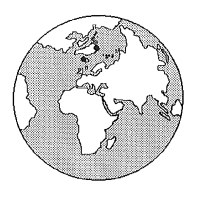Eastern Greenland
David Laughton
Will Lacy and David Laughton spent the last two weeks of August, 1995 in the Arctic. They flew up to Longyearbyen in Spitsbergen where they joined a small Russian ice-strengthened ship, The Professor Molchanov. Then fellow passengers were a mixed bunch of Dutch, German, Austrian and 18 South Africans plus a couple of other Brits. – 38 in all.
Only one day was spent in Spitsbergen looking around Longyearbyen (rapidly developing its tourist industry) then crossing Isfjord for a long walk around the huge bird cliffs of Alkhornet. The ship then sailed for N.E. Greenland, a smooth crossing of two days SW aiming for Myggebukten on Hold With Hope. Unfortunately very thick pack ice, which had first been encountered half way across the Greenland Sea, prevented an approach closer than 30 miles. Now also in thick fog, it was decided to head south for Scoresby Sund (70 °N) where a satellite ice report showed more prospect of getting ashore.
Scoresby Sund is the largest fjord in the world, 15 miles wide at the entrance and reaching inland some 200 miles as far as the Greenland ice cap. It was discovered by William Scoresby, a very successful Whitby whaler, in 1822. Although there had been a few very small Innuit (Eskimo) settlements on the banks of the fjord many centuries ago it was not until 1925 that the Danish government, then administering Greenland, set up a new settlement also called Scoresbysund on the north bank just inside the entrance. This has now grown to some 500 people and given the Greenlandic name of Ittoqqortoormiit. As a current prominent citizen of Whitby Will Lacy is keen to develop a relationship between Whitby and Scoresbysund in recognition of Scoresby’s (Senior & Junior) links with the town and the fact that they are second only to Cook in the towns historic links with exploration at sea. Will had taken with him presents from the Mayor of Whitby and proposals for closer links.
The ship did manage to enter the fjord after much banging and craslring through the ice but was not initially able to approach the village However the fjord was navigable although littered with thousands of icebergs, ranging from foot wide blocks to ¼ mile long monsters. A week was spent exploring the fjord, landing at least once a day for extensive walks over the tundra and climbing some of the minor peaks. The scenery and the weather were magnificent. To the north lay the snow clad Stauning Alps and to the south the Watkin Mountains with huge rock walls, split by glaciers coming right down to the sea. There was also plenty of wildlife with musk-ox grazing on the slopes, Snowy Owls, Gyr Falcon, and many flocks of Snow Bunting plus Black Throated Diver, geese and many varieties of seabirds.
Before leaving the fjord another attempt was made to reach the settlement, the approach to which still looked impossible. However the very experienced Russian captain eventually forced a way through and in brilliant sunsliine a landing was made. Accompanied by a Danish interpreter Will and David attended a meeting of the town council where Will presented the Whitby gifts and accepted gifts in return. The locals still live mainly by hunting; so far this year they have killed and eaten 60 polar bears as well as a number of musk-ox and innumerable seals. Unfortunately drink appears to be a major problem and at 5 pm the shop started to sell alcohol with the depressing sight of all ages coming away with cartons of beer and bottles of stronger stuff, several already drunk.
Farewells were said and the ship battled its way through very thick ice out to sea to drop off the passengers at Akureyri in northern Iceland. This last 33 hour leg was enlivened by five large Humphack whales playing around the ship for almost an hour. An overnight stop in Reykjavik then home accompanied on the plane by 45 youthful members of a British Schools Exploration Society expedition to Iceland.
